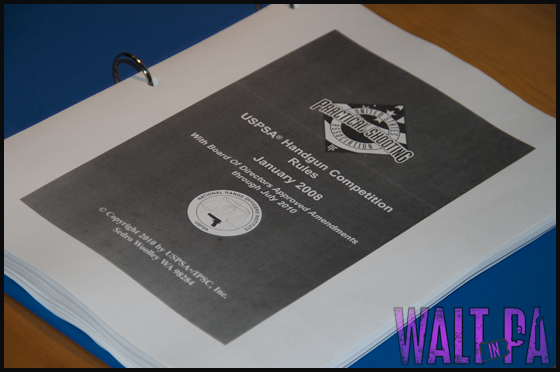
Earlier this week I posted the first, of what I hope will be many, Community Developed USPSA Stages. I was happy with the feedback that I received and think it is about time to make the first revision. Before I start making revisions, I want to share two items. The first is a problem with the stage that needs to be adressed. The second is how someone would go about shooting the stage as-is.
Illegal Stage
Going into the design of this stage, I wasn’t sure about the No-Shoot Swinger. I don’t recall ever seeing one, in person or in a YouTube stage being shot. I glanced over the USPSA Rule Book but didn’t see anything barring me from orienting my target in such a way.
In the comments section, I received a note from a friend. He explained that he thought the No-Shoot Swinger created a stage design problem which rendered it illegal.
From Scott via Comments Section:
I hate to sound like a dick but I think ( I could be wrong ) you made an illegal stage , if you shoot the no shoot and the bullet passes through and hits the target behind it , it would be considered range equipment malfunction and a reshoot would be mandatory.
Scott’s comment reminded me of a similar situation that I came across in my First USPSA Match. During that match, there was a stage which placed a No Shoot at the base of a Texas Star. Competitors seemed upset by this as the last piece of the Texas Star had a tendency to stop behind the No-Shoot. In what I thought was a little on the unsportsmanlike side of the issue, several competitors shot through the No-Shoot to engage the steel and forced a re-shoot due to range equipment failure.
I printed off all 108 pages of the USPSA Rule Book and started reading through it, looking for something that would either allow my No-Shoot Swinger to stay, or be a definitive “Get Rid of It”. My first stop was in the section on Targets. I found something that sort of fit the situation.
From The USPSA Rule Book:
4.1.4.2 Cover provided merely to obscure targets is considered soft cover. Shots which have passed through soft cover and which strike a scoring target will score. Shots that have passed through soft cover before hitting a no-shoot will be penalized. All scoring zones on targets hidden by soft cover must be left wholly intact. Targets obscured by soft cover must either be visible through the soft cover or a portion of the affected target(s) must be visible from around or over the soft cover.
From there I went to the section of the rule book on Range Equipment Malfunctions. I couldn’t find anything that fit the situation and was left with no firm answer. I decided to contact the guys over at The Power Factor Show and see if they could lend a hand.
and see if they could lend a hand.
The first time my stage was looked over, the No-Shoot Swinger was missed (in my rendering it looks just like an angled piece of hard cover). My attention was directed to another section of the rule book on Scoring
From the USPSA Rule Book:
9.1.4 Unrestored Targets – If, following completion of a course of fire by a previous competitor, one or more targets have not been properly patched or taped or if previously applied pasters have fallen off the target for the competitor being scored, the Range Officer must judge whether or not an accurate score can be determined. If there are extra scoring hits or questionable penalty hits thereon, and it is not obvious which hits were made by the competitor being scored, the affected competitor must be ordered to reshoot the course of fire. For the purpose of this rule, B-zone and C-zone hits shall be considered one and the same
Impenetrable – The scoring area of USPSA scoring targets and noshoots is deemed to be impenetrable:
9.1.5.1 If a bullet strikes wholly within the scoring area of a paper target, and continues on to strike the scoring area of another paper target, the hit on the subsequent pape
In a nutshell, this means that all targets are impenetrable, including my No-Shoot Swinger. If a bullet passes through the No-Shoot Swinger and strikes the target beyond, it can not be scored. This triggers rule 9.1.4 and the Range Officer must determine if it went through the impenetrable target or was shot in another way. Because the swinger is moving, there is no good way to make this determination.
What all this boils down to is that the heart of my stage, which was the No-Shoot Swinger, isn’t going to work. The guys from The Power Factor Show made some suggestions on how to resolve the problem (using a steel No-Shoot in a static position infront of a standard Swinger) or I could simply re-design this portion of the stage.
While this isn’t what I wanted to hear, I think this has been a valuable lesson on Stage Design. I am not discouraged in the least and think a revision is in order (that is the purpose of this community stage design project anyway).
Shooting the Stage
Despite having a problem with the stage design, I was thrilled to receive feedback on how the stage could be shot. Justin, @HerfDoctor on Twitter , sent me a detailed plan on how he would go about attacking the stage.
, sent me a detailed plan on how he would go about attacking the stage.
From Justin:
Hi Walt,
This is Justin from Facebook or @HerfDoctor from Twitter. I like the idea of your community based USPSA stage design. I’ve never shot in USPSA so what I would do might or might not make sense. I attached my plan as a JPG file where I just drew over your stage design. By the way, the stage is really cool and I can see lots of target transitions and a few shooter position changes, and only one or two reloads depending on the shooter.
As for the way I’d attack the course: I would start with the poppers from right to left so that the swinger is engaged pretty much from the beginning and it can slow down a bit by the time the target behind it is to be engaged. Also by starting out from right to left, the shooter ends the poppers by facing the paper target on the left and can immediately approach it without having to twist or turn. I made the arrow indicating the shooter position movement bent just so it didn’t overlap with the target shooting arrows, the shooter would run in a straight line to engage the left side paper target. After the left side paper target is done, the shooter takes a few steps to the side to engage the right side paper targets and in the moving process the shooter can determine if a reload is necessary based on their shot count up to that point. After the right side paper targets are done, a reload is most likely needed as the shooter transitions forward to engage the forward paper targets. I would approach the forward paper targets from left to right so that the swinger has had the most time to slow down and give more time to drop two rounds into the paper target behind it, finally finishing on the right-most paper target in the front.
Like I said, that might or might not make sense, but I think it tends to reduce the shooter transitions and reloads, as well as working out the timing of the swinger to be slowed down the most by the time the shooter needs to worry about the target behind it.
Looking forward to your thoughts on my approach.
Regards,
Justin
For not being a USPSA Shooter, Justin’s plan was better than my own. My plan was identical to Justin’s right up until the end. I would have transitioned from Justin’s Target #8 to #11 to allow the swinger to slow down even more. Seeing everything laid out on paper, I think this would have created wasted movement in a unnecessary transition.
If Justin and I shot this stage and cleared it with a perfect score, on paper, Justin would have shot it marginally faster and beat me. I’m thrilled by this, not only did a learn a few things about stage design, I also learned a better way to shoot my own stage. This is precisely what I hoped to get out of this community driven stage design.
Please keep the shooting plans and revisions coming. I’ll be sitting down to make a few revisions later this week. Once posted, we can go through this all over again. If you have an idea for a completely different stage, please feel free to send them to me for a future community stage design.
Click Here to See the Post
That Prompted this Post
One thought on “Community USPSA Stage: Shooting and Resolving a Problem”
Comments are closed.
Recent Posts
The Price of Rushing: A Winter Riding Story & Four Years of YouTube Friendship
You know those moments when you do something that isn't exactly catastrophically stupid, but just stupid enough to make you shake your head at yourself? Yeah, we've all been there, and today I'm...
Finding Joy in Unexpected Places: A Memorable Motorcycle Ride to Remember
As we roll into 2025, I've been reflecting on the rides that made 2024 special. While the year didn't provide as many opportunities to hit the road as I'd hoped, one particular adventure stands out...


Just giving ya something to do buddy!!! hahah